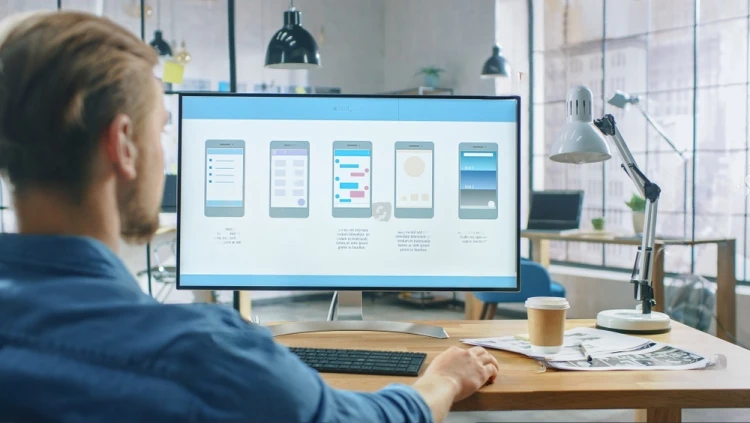I. Introduction
In the rapidly advancing digital age, characterized by a scarcity of user attention and fierce competition, the importance of UI/UX design is paramount. As we journey through the realms of websites and applications, the seamless and intuitive experiences we encounter are a direct outcome of meticulous UI/UX design and development. Let’s delve deeper into the realm of UI/UX and unravel how these services play a pivotal role in shaping the digital landscape.
II. The Basics of UI/UX Design
Understanding User Interface (UI)
User Interface (UI), a pivotal aspect of digital platforms, encapsulates an array of visual elements and components meticulously designed for user interaction. This multifaceted realm extends beyond mere aesthetics, delving into the intricacies of user engagement. From the interactive buttons that prompt user actions to the thoughtfully chosen color schemes that evoke specific emotions, every nuanced detail weaves into the fabric of the overall user experience.
In the dynamic landscape of digital design, the artistry of UI unfolds as a comprehensive orchestration of elements, harmonizing visuals to craft an environment that seamlessly resonates with the user.
Exploring User Experience (UX)
User Experience (UX) is centered on the all-encompassing journey that users undertake when interacting with a product or service. It extends beyond individual interactions, delving into the intricacies of the entire user journey. Two fundamental pillars that underpin the essence of UX design are user journey mapping and information architecture.
These critical components serve as the bedrock, guiding the seamless flow and structure of the user experience. In the intricate realm of UX design, these elements act as navigational beacons, ensuring that the user’s interaction is not just a series of isolated moments but a cohesive and meaningful journey through the digital landscape.
III. The Role of UI/UX in Website Development
The influence of UI/UX design stretches far beyond mere aesthetics; it assumes a pivotal role in elevating user engagement and wielding a substantial impact on conversion rates. A website meticulously crafted with UI/UX considerations is not merely a visual delight but a potent tool for cultivating a positive user experience. This positive interaction, in turn, becomes a catalyst for heightened user satisfaction and fosters unwavering brand loyalty.
In the intricate dance between design and user interaction, a well-crafted website emerges not only as a virtual space but as a dynamic platform that resonates with users, leaving an indelible mark on their digital journey.
IV. Key Principles for Effective UI/UX Design

Simplicity and Clarity
Simplicity and clarity stand as cornerstone principles in the realm of design, emphasizing the importance of keeping designs straightforward and easily comprehensible. The essence lies in ensuring that users can effortlessly navigate through a website or application, devoid of unnecessary complexities that might impede their seamless interaction.
By adhering to this foundational principle, designers create an environment where users can intuitively explore digital spaces without grappling with convoluted structures, fostering an experience that is both user-friendly and gratifying.
Consistency Across Platforms
Ensuring a consistent user interface across diverse platforms cultivates a sense of familiarity, simplifying the adaptation process for users. This uniformity serves as a guiding principle, allowing users to seamlessly transition between various platforms with ease.
Consistency in the user interface becomes a reassuring element, enhancing user experience by eliminating the need for constant reorientation and contributing to a more intuitive and user-friendly digital environment.
User Feedback Integration
The invaluable nature of user feedback in refining UI/UX design cannot be overstated. It is imperative to incorporate mechanisms for feedback, fostering a dynamic loop that continuously evolves based on user suggestions and preferences. By actively engaging with user input, the design adapts and improves, ensuring a responsive and user-centric digital experience. This iterative process not only enhances the UI/UX but also strengthens the connection between users and the digital interface.
V. Trends in UI/UX Design
Dark Mode
Dark mode has become a popular feature, providing a visually appealing and energy-efficient alternative to traditional light interfaces.
Microinteractions
Microinteractions add a touch of dynamism to user interactions, enhancing the overall user experience with subtle animations and feedback.
Voice User Interface (VUI)
With the rise of voice-activated devices, integrating VUI in design provides a hands-free and accessible interaction method.
VI. The Evolution of UI/UX in Mobile Apps

Over the years, the user interface (UI) and user experience (UX) design of mobile apps have undergone significant evolution. In the early days, mobile interfaces were often basic and utilitarian, focusing primarily on functionality. However, as smartphones became more sophisticated, designers started emphasizing user experience and aesthetics.
Responsive Design
In the mobile-centric era, responsive design ensures a seamless user experience across various devices and screen sizes.
Touch Gestures
Mobile apps leverage touch gestures for intuitive navigation, providing a tactile and engaging experience.
Mobile-First Approach
Prioritizing mobile design ensures that the user experience is optimized for the growing number of mobile users.
VII. Importance of Accessibility in UI/UX
Accessibility in UI/UX design is crucial for ensuring that digital products and services are usable and inclusive for all individuals, regardless of their abilities or disabilities. Here are key reasons why accessibility holds paramount importance in UI/UX:
Inclusive Design
UI/UX should be inclusive, catering to users with diverse abilities. Inclusive design ensures a positive experience for all users.
Compliance with Web Content Accessibility Guidelines (WCAG)
Adhering to WCAG standards is crucial for making digital content accessible to individuals with disabilities.
VIII. Hiring UI/UX Design and Development Services
When seeking UI/UX design and development services for your project, it’s essential to follow a strategic approach to ensure the success of your digital product. Here are key steps to consider in the hiring process:
Benefits of Outsourcing
Outsourcing UI/UX services offers businesses the invaluable opportunity to tap into a reservoir of specialized expertise, guaranteeing not only high-quality design and development but also a strategic advantage in the ever-evolving digital landscape.
Selecting the Right Service Provider
Choosing the right UI/UX service provider involves evaluating their portfolio, and expertise, and understanding how well they align with the business’s vision.
IX. Case Studies: Successful UI/UX Transformations
This section showcases real-world examples of projects where the redesign and optimization of user interface (UI) and user experience (UX) led to significant improvements in usability, engagement, and overall user satisfaction.
Through detailed narratives, these case studies highlight the challenges faced, the strategies employed, and the measurable outcomes achieved in successfully transforming the UI/UX of various digital products or platforms
Before and After Examples
Examining real-world examples of UI/UX transformations showcases the tangible impact on user satisfaction and business outcomes.
Positive Impact on User Satisfaction
Implementing effective UI/UX strategies has a direct correlation with increased user satisfaction, fostering long-term customer relationships.
X. Challenges in UI/UX Design and Development
Designing and developing user interfaces (UI) and user experiences (UX) for digital products come with various challenges that demand careful consideration and creative solutions. Some common challenges include:
Balancing Aesthetics and Functionality
One of the challenges is finding the equilibrium between aesthetically pleasing designs and functional user interfaces.
Keeping Up with Technological Advancements
The rapid evolution of technology poses the challenge of staying abreast of the latest trends and integrating them seamlessly into UI/UX design.
XI. Future Prospects in UI/UX Design
The field of UI/UX design is dynamic, and its future holds exciting possibilities shaped by technological advancements, changing user expectations, and evolving industry trends. Several key trends and prospects are anticipated in the coming years:
Emerging Technologies
The integration of emerging technologies like augmented reality and artificial intelligence is poised to revolutionize UI/UX design.
Predictions for the Industry
Experts predict a continued focus on personalization, interactivity, and immersive experiences as the industry evolves.
XII. Tips for Aspiring UI/UX Designers
For those venturing into the dynamic field of UI/UX design, navigating the intricacies of creating intuitive and visually appealing user experiences can be both challenging and rewarding. This guide offers essential tips to aspiring UI/UX designers, providing valuable insights to help them cultivate their skills, stay updated on industry trends, and approach design projects with a user-centric mindset
Continuous Learning
The field of UI/UX design is dynamic, and aspiring designers should engage in continuous learning to stay updated with industry trends.
Building a Strong Portfolio
A robust portfolio showcasing a designer’s skills and diverse projects is crucial for attracting potential clients or employers.
XIV. Frequently Asked Questions (FAQs)
A. What is UI/UX design?
UI/UX design refers to the process of creating user interfaces and experiences for digital products, such as websites and applications. It involves considering the visual elements, user interactions, and overall journey to ensure a seamless and satisfying user experience.
B. How does UI/UX impact user engagement?
Effective UI/UX positively influences user engagement by providing an intuitive and enjoyable experience. Users are more likely to stay on a website or use an app that is easy to navigate, visually appealing, and meets their needs efficiently.
C. What are the current trends in UI/UX design?
Current trends include the adoption of dark mode for visual comfort, the use of micro-interactions for added dynamism, and the integration of voice user interfaces (VUI) for hands-free interactions.
D. Why is accessibility crucial in UI/UX?
Accessibility ensures that digital products are usable by individuals with diverse abilities. It involves designing interfaces that can be navigated and understood by everyone, including those with disabilities, following standards like the Web Content Accessibility Guidelines (WCAG).
E. How can businesses benefit from hiring UI/UX services?
Businesses benefit from hiring UI/UX services by enhancing user satisfaction, increasing conversion rates, and staying competitive in the digital landscape. Professional design services contribute to a positive brand image and user loyalty.
XIII. Conclusion
In conclusion, UI/UX design and development services emerge as pivotal architects in shaping the digital experience. Delving into the basics of design principles, these services intricately craft the foundation upon which seamless and engaging user interactions unfold. The symbiotic relationship between users and digital interfaces is curated and enhanced through the meticulous efforts of UI/UX design, underscoring its indispensable role in defining the landscape of our digital encounters.







